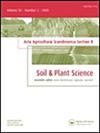长期大蒜-水稻轮作提高了水稻土的保氮能力
IF 1.8
4区 农林科学
Q2 AGRONOMY
Acta Agriculturae Scandinavica Section B-Soil and Plant Science
Pub Date : 2023-01-23
DOI:10.1080/09064710.2023.2167668
引用次数: 0
摘要
本文章由计算机程序翻译,如有差异,请以英文原文为准。
Nitrogen retention capacity of paddy soil improved under long-term garlic-rice rotation
ABSTRACT Although significant differences in soil nitrogen levels exist under different paddy-upland rotations, the main reason for this is unclear. The nitrogen retention capacity and loss of ammonia volatilisation, leaching, etc. of paddy soil with large differences in nitrogen levels from two long-term rotations, garlic-rice and wheat-rice, were measured using the soil column simulation method. The results showed that the loss rate of leaching was only 5.4%, whereas that of ammonia volatilisation was up to 22.8%, which was the main nitrogen loss way of paddy soil under the two rotations. The average ammonia volatilisation rates under wheat-rice rotation with high and low nitrogen application rates were 12.1% and 40.2% higher than that under garlic-rice rotation, leading to a decrease in the total nitrogen loss amount and rate through ammonia volatilisation by 29.8% and 8.8%, respectively. As a result, nitrogen retention in the soil under garlic-rice rotation increased by 12.7%. In conclusion, the long-term garlic-rice rotation could significantly inhibit ammonia volatilisation, thus improving the soil nitrogen retention capacity. The straw return may increase soil organic matter content, reduce ammonia volatilisation loss, and enhance soil nitrogen retention capacity and productivity.
求助全文
通过发布文献求助,成功后即可免费获取论文全文。
去求助
来源期刊
CiteScore
4.40
自引率
0.00%
发文量
56
审稿时长
2.3 months
期刊介绍:
Acta Agriculturæ Scandinavica Section B publishes original research in applied soil and plant science with special attention given to to crop production in agri- and horticultural systems. We welcome manuscripts dealing with:
Climate smart and sustainable crop production systems
Water and nutrient efficiency
Soil conservation and productivity
Precise agriculture systems
Applications of bio- and nanotechnology
Digitalisation and robotics
Soil-plant interactions
Acta Agriculturæ Scandinavica, Section B – Soil & Plant Science forms part of a series of titles published on behalf of the Nordic Association of Agricultural Science (NJF). The series also includes Section A - Animal Science .

 求助内容:
求助内容: 应助结果提醒方式:
应助结果提醒方式:


